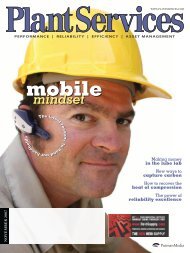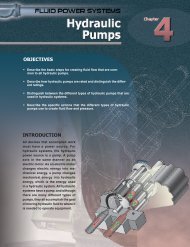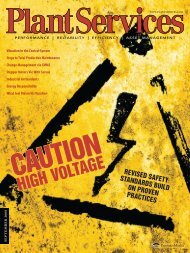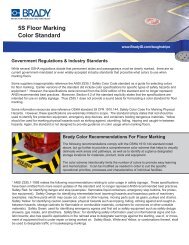POWER UP A WINNER - Plant Services
POWER UP A WINNER - Plant Services
POWER UP A WINNER - Plant Services
You also want an ePaper? Increase the reach of your titles
YUMPU automatically turns print PDFs into web optimized ePapers that Google loves.
up & Running<br />
Automation and Power Joined in oRlando<br />
ABB event acknowledges economy, focuses on efficiency<br />
Despite economic uncertainties and tight travel budgets,<br />
more than 3,300 ABB representatives, partners and users met<br />
March 23-25 in Orlando, Fla., to share practices, identify trends<br />
and check out 72,000 sq. ft. of exhibits designed to help them<br />
make the most of automation and power systems.<br />
The consensus is that the current economic climate is only a<br />
temporary impediment and distraction from pursuing the rich<br />
potentials in optimizing production, increasing reliability and<br />
improving energy efficiency that can come from integrating<br />
process and electric power monitoring and control.<br />
Among the more than 500 presentations was “Electrical<br />
Integration: A Strategy for Achieving Unified Operations<br />
resources<br />
Calculate cost of condition monitoring<br />
Azima DLI’s WATCHMAN in-house condition-monitoring<br />
program cost calculator allows plant and maintenance<br />
managers to calculate the annualized cost of current<br />
machine condition-monitoring programs to help determine<br />
the right mix of on-site and outsourced solutions. Complete<br />
a brief questionnaire to get a detailed assessment.<br />
www.plantservices.com/industrynews/2009/061.html<br />
See real-world results of energy audits<br />
In 2006, the U.S. Department of Energy (DOE) launched<br />
energy-saving assessments at six industrial plants. As of<br />
March 2009, it has completed 2,053 assessments, and<br />
1,873 of the plants have identified energy cost savings totaling<br />
more than $1.2 billion, implemented savings totaling<br />
more than $190 million, and documented potential carbon<br />
dioxide emissions reductions of 10.3 million metric tons.<br />
www.plantservices.com/industrynews/2009/057.html.<br />
Dig into performance-BAsed outsouRCing<br />
The University of Tennessee (UT) offers instruction on<br />
getting the most from service providers using performance-based<br />
outsourcing (PBO), starting with the article<br />
at the link below. “Companies wanting to improve their<br />
relationships should have a sound guidebook,” say authors<br />
Kate Vitasek and Mike Ledyard, so you’ll also find<br />
links to a free book and UT classes on the subject.<br />
www.plantservices.com/articles/2009/046.html<br />
and Extended Asset Management,” by Stefan Bollmeyer,<br />
ABB fieldbus product manager for its System 800xA.<br />
“Electrical integration is the next frontier in driving productivity,<br />
increasing safety and reducing costs,” Bollmeyer said.<br />
“It enables users to achieve total plant visualization so they<br />
can make decisions based on dollars and cents, and not just<br />
on temperatures and voltages,” Bollmeyer said. “This also<br />
means they maximize production by reducing the impact of<br />
an unreliable power supply, as well as reduce energy costs by<br />
conducting peak shaving.”<br />
“Electrical integration also allows users to reduce operational<br />
costs by unifying their operations environment, performing<br />
condition-driven maintenance, reducing spares and training,<br />
and establishing cross-discipline cooperation. They further can<br />
reduce investment costs by minimizing cabling and engineering,<br />
by implementing an optimized network design and by<br />
establishing asset management for their electrical subsystems.”<br />
Despite these potential gains, Bollmeyer added that several<br />
persistent barriers continue to block electrical integration.<br />
“In the past, electrical integration was hampered by a<br />
lack of communication standards and architectural design,<br />
high project execution and commissioning costs, and high<br />
life cycle costs,” he said. “Organizational barriers among<br />
departments within plants and suppliers also have hindered<br />
integration, and these mind-set-based barriers often are<br />
harder to deal with than the technical challenges to integration.<br />
Many users have their own department and kingdoms,<br />
and they want them to stay just as they are.”<br />
To help process control and power staffs cooperate on<br />
achieving better electrical integration, ABB recommends<br />
they adopt a unified integration method based on a single<br />
system environment, use a fieldbus network to handle electrification<br />
control and management, and use the IEC 61850<br />
standard to tie together process instrumentation, process<br />
electrification and power distribution networks.<br />
For example, he reported that using IEC 61850 to integrate<br />
MV motor controls gives users several benefits, including<br />
fewer cables, easier installation, higher performance,<br />
alarm and events from devices, and improved diagnostics.<br />
In his presentation on the company’s future direction, Peter<br />
Terwiesch, ABB chief technology officer, outlined how ABB<br />
will continue to help industry save energy and improve productivity.<br />
“Across all industries, 80% of energy is lost between<br />
generation and use. It’s a leaky pipe, as it were,” Terwiesch said.<br />
12 APRIL 2009 www.PLANTSERVICES.com












